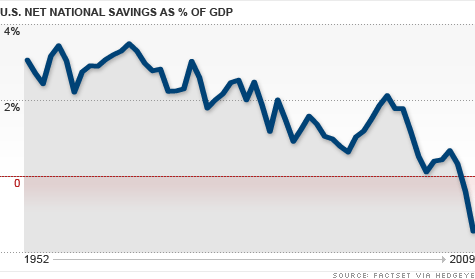FORTUNE -- The long decline of the savings rate in the United States has been widely discussed, yet every revisit of the data brings new cause for alarm. Hedgeye recently provided its clients a chart showing savings as a percentage of GDP. In the 1970s and 1980s savings were in the 5 - 7% range. In the decades since, personal savings have declined to the 1 - 3% range.
Many pundits suggest the decline in savings is a non-issue, while others, more on the extreme, believe that it one of the primary economic issues currently facing the United States. While the implications can be debated, the fact remains that the savings rate has declined dramatically over the past few decades and is among the lowest of any modern nation state.
As a refresher, the basic formula used to calculate savings rate is as follows:
(Disposable Personal Income -Taxes - Expenditures = Savings) / Disposable Personal Income
The Bureau of Economic Analysis keeps this statistic via its NIPA (National Income and Product Accounts) savings rate. The expenditures include interest payments, but exclude mortgage payments.
Critics of this calculation suggest there are a couple of major factors that are excluded that should be included, which are primarily: homes and capital gains on stock sales. Specifically, as we purchase a home and pay down our mortgage, and the home appreciates in value, it is a form of savings. And as it relates to stock sales, when we realize capital gains this increases our net worth and, ostensibly, our savings.
Despite the debate over calculations, the savings rate is still a decent proxy for the American consumer's savings rate and, more importantly, the direction of those savings, especially as it has been calculated with some consistency by the Department of Commerce, over time.
As the Federal Funds Rate -- a rough proxy for the interest earned in savings accounts -- has decresed, so, too, has the rate that American consumers have saved. Logically, this makes sense as consumers have shifted out of savings accounts due to the declining rate of return.
In the short term, the savings rate has increased slightly, but based on the long term trend of interest rates down and savings rate down, it seems that a more sustained increase in savings is unlikely until consumers incentivized to save via higher interest rates. Given the recent rhetoric from the Federal Reserve, it seems unlikely that we will see a meaningful increase in interest rates anytime soon.
In the alarming chart above, we've outlined the broad savings rates within the U.S. economy. This is a combination of consumer based savings, government savings via surpluses (or lack thereof), and corporate savings. In early 2009, savings in aggregate as a percentage of GDP went negative for the first time since 1952, and has continued its downward trend.
One potential economic risk to the low savings rate is that U.S. consumers retrench and opt to change their consumption patterns and instead of spending, they aggressively begin to save. This would be a "reversion to the mean" theory of savings and is a somewhat fanciful idea absent an increase in interest rates.
A larger issue facing the United States in increasing its savings rates relates to demographics. Specifically, old people save less than young people. So, as a population ages the savings rates will naturally decline, and create headwinds to increasing that rate. In the United States, the population is clearly aging. According to a 2006 report on demographics from the United States Congress, by 2025 18% of the population will be over 65 years old, versus 12% in 2000.
More broadly, the primary risk of a lack of savings in the United States, be it personal, corporate, or governmental, is an inability to fund, via domestic means, the large deficits being run by the federal government -- currently at north of 10% of GDP. Specifically, if we do not have enough savings to buy our own government debt, then we will have to rely on foreigners to purchase that debt.
What's worse: foreign oil, or foreign creditors?
While the issue of dependence on foreign oil is accurately raised as a real economic and strategic risk to the United States, what about this risk related to a dependence on foreign debt financing? The combination of a low domestic savings rates and lack of government savings (i.e., a massive deficit) means that the United States will continue to rely on foreign financing to bridge deficits well into the future.
The future reliance of foreign financing can be alleviated in a few ways: a dramatically increased savings rate, economic growth that narrows the gap, an increase in tax revenues to pay for the deficit, aggressive austerity measures that reduce budget deficits. Currently, none of these seem very likely to change.
Source: By Daryl G. JonesJune 30, 2010: 3:39 PM ET
Daryl G. Jones is the Managing Director of Risk Management at Hedgeye, a research firm based in New Haven, Conn. His colleague Darius Dale also contributed to this column.
--
Daniel Escobar
EES
 Imaginad que comprimís el último millón de años de la historia de la humanidad en sólo un año.
Imaginad que comprimís el último millón de años de la historia de la humanidad en sólo un año.



 TeleSUR _:
TeleSUR _: